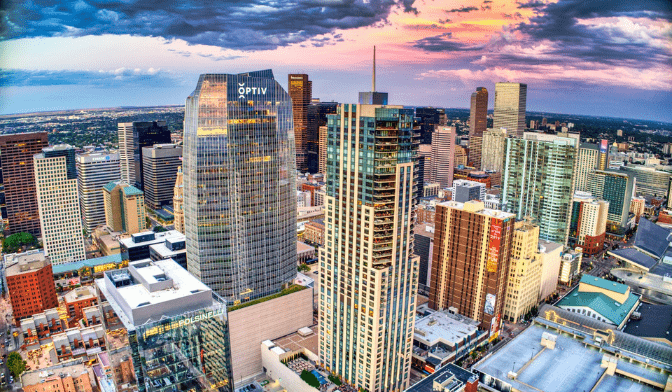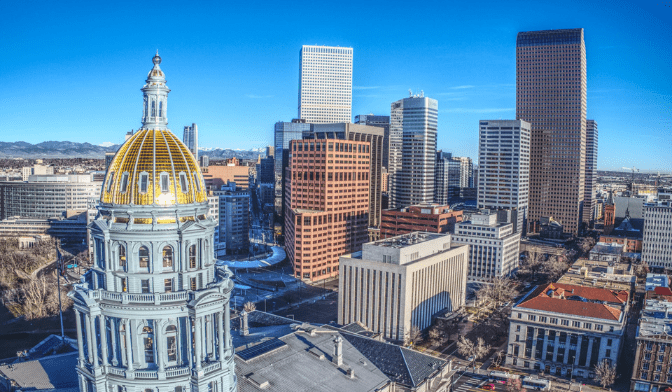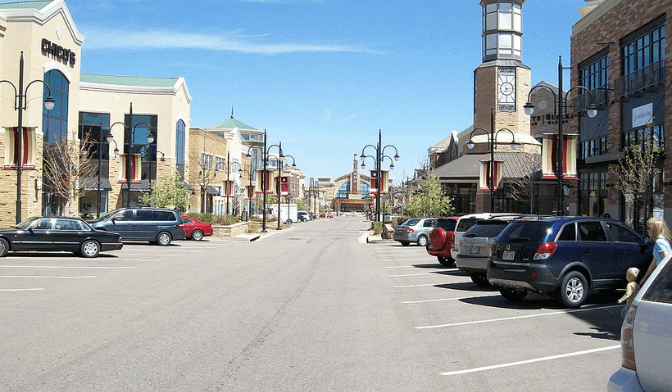Rocky Mountain Highs & Lows: The moveBuddha 2023 Denver Migration Report
Denver faces numerous challenges as a new mayor is poised to take office for the first time in 12 years. moveBuddha data shows moving interest to Denver was positive from 2020 and early 2023, but there’s a catch. Folks are fleeing the city’s expensive housing, crime, and homelessness to head for the suburbs.
Big takeaways
- Denver is still drawing interest from new residents. Moving interest in the Denver MSA ebbed and flowed between 2020 to early 2023, but it was largely positive. There were only three months when moving interest dipped into the negative territory.
- Escape from the city. Denver’s outlying suburban areas saw the most moving interest between 2020 and early 2023, including cities like Westminster, Aurora, Arvada, and Littleton. Zip codes in Denver’s city limits were the exact opposite and saw sustained move-out interest.
- The Pacific Northwest is calling. Most people who leave Denver stay within Colorado. But if Denver residents leave the state, moveBuddha data shows they’re most interested in Portland, Oregon; and Seattle.
Denver’s at a Crossroads
On the surface, Denver has many things going for it. The Denver MSA has seen steady growth over the past two decades, has a thriving music and culture scene, and has become a magnet for tech workers.
And let’s not forget about the city’s sports scene, hosting squads from all four major pro leagues. The Denver Nuggets, led by Nikola Jokic, recently won their first NBA championship in franchise history.
New moveBuddha data shows that people nationwide are interested in moving to Denver and the surrounding area. Nevertheless, the Mile High City faces several formidable challenges.
Violent crime has spiked in Denver since the pandemic, and crime rates remain elevated. Homelessness has become a significant problem in the city. And many people can no longer afford to live in the city’s confines.
While moveBuddha data show that move-in interest to Denver has remained strong from 2020 to early 2023, there’s a caveat. Nearly all the Denver metro area zip codes showing positive move-in-to-move-out ratios are outside the city limits and in towns surrounding the city, like Aurora and Arvada.
Let’s dig deeper into the data about Denver moving trends to see the timeline of move-in interest and other noteworthy trends.
Table of Contents:
I. Denver Timeline – Timeline of searches for moves
II. Denver Neighborhood Trends
III. Which Cities are Moving to and From Denver?
IV. Denver 2100 Projections
V. Methodology
I. Timeline of Moves to and from Denver: Interest isn’t Mile-High, but it’s Largely Positive
Denver’s population has surged since the ‘90s. Between 2010 and 2020, the population grew by 19.2%. But are the boom times ending?
The U.S. Census Bureau estimates that between 2020 and 2021, the Mile High City’s population declined for the first time in a decade. New Census figures show the trend reversed between 2021-2022, but only slightly. Denver’s population grew by a mere 0.27% during that time.
moveBuddha’s new Denver moving data offers another perspective. Move-in-to-move-out interest in the Denver metropolitan area ebbed and flowed from 2020 to early 2023, but it was largely positive.
Move-in interest in the Denver area was highest between August and December 2020. This may be due to remote workers moving to the area during the height of the pandemic. Interest in moving to Denver declined in the first half of 2022, reaching a search volume ratio low of 1.03 in May of last year.
But the Denver MSA finished 2022 strong. From July to December, move-in interest picked back up and finished in December at a rate of 1.84. Move-in interest in Denver has remained largely positive so far in 2023 (through April 6th). But the volume of interest has slowed, with a mediocre ratio of 1.06 in February and an early negative ratio in April.
II. Packing up and leaving the city
There’s a caveat to the mostly positive move-in interest for Denver. moveBuddha’s study examined the entire metro area. And while movers nationwide may still be interested in the Mile High area, most don’t want to live within Denver city limits.
In the past several years, nearly all the zip codes seeing positive search interest in Denver were in the suburbs. That includes towns like Westminster, Aurora, and Arvada. The Denver zip code of 80202 saw a highly positive ratio, but that’s likely because it’s the default zip code people search for.
Top 5 zips to move to in Denver in 2023:
| Zip Code | Neighborhood | In/Out Ratio |
| 80023 | Broomfield | 2.67 |
| 80206 | Denver | 2.63 |
| 80202 | Denver | 2.39 |
| 80401 | Golden | 2.08 |
| 80011 | Aurora | 1.67 |
Top zips to move out of Denver in 2023:
| Zip Code | Neighborhood | In/Out Ratio |
| 80016 | Aurora | 0.32 |
| 80129 | Highlands Ranch | 0.40 |
| 80203 | Denver | 0.43 |
| 80112 | Centennial | 0.53 |
| 80111 | Cherry Creek | 0.56 |
The zip codes that saw the worst move-in-to-move-out ratio in 2022 were primarily concentrated in Denver’s city limits. Highlands Ranch and Parker also saw low search volume ratios in 2022. Some of the zip codes that saw the worst ratios in early 2023 were also neighboring cities like Highlands Ranch, Centennial, and Cherry Creek.
The search volume ratios have been different so far in 2023, but they largely reflect the trends from the past few years. Some Denver suburbs are faring worse in 2023, and some Denver city zip codes are doing better, but it’s still early, and we’ve yet to see a full year of data.
III. Which Cities Are Moving to and from Denver?
- A brief, pandemic-fueled boom. Denver was a popular locale for other big city residents in 2020. Brooklyn, Minneapolis, and San Francisco residents showed significant interest in Denver that year, along with Chicago, New York City, Orlando, and Washington, D.C.
- CHI<DEN. Of all the major cities studied between 2020-2023, Chicago residents showed the most consistent interest in Denver. The ratio of move-in-interest peaked in 2020 and has waned since then. But in early 2023, it was still a healthy 2.29.
- Where are Denver folks heading? Denver residents interested in packing their bags showed consistent interest in several cities from 2020 to early 2023. The top three were Portland, Oregon; Tampa, Florida; and Colorado Springs, Colorado. Other cities where Denver folks may be heading include Seattle; Raleigh, North Carolina; and Nashville.
Newcomers from the Windy City
Chicago is a major U.S. city having its own problems with residents fleeing for greener pastures. moveBuddha data shows that one of the top areas folks from Chi-town are interested in moving to is the Denver area.
Chicago showed consistent interest in Denver from 2020 to early 2023. The move-in-to-move-out ratio in 2020 was 5.57. That means that for every 100 Denver residents who searched for a move to Chicago in 2020, another 557 Chicago residents were looking to move to Denver. The ratio declined to 4.43 in 2021, 2.55 in 2022, and 2.29 in early 2023, but it was still among the highest of all cities showing interest in relocating to the Denver area.
Some Texas residents also showed heavy interest in Denver in 2022. Dallas and Austin ranked high in Denver move-in interest, and San Diego and Washington, D.C., residents also considered a Mile High move.
In early 2023, Texas residents again showed strong interest in Denver. Austin and Houston are among the top 5 cities interested in moving to the Denver MSA so far this year. Phoenix and Washington, D.C., residents are also interested in Denver. But Brooklyn has taken the top spot so far in 2023.
Top cities moving into Denver in 2023; Cities with the highest ratio of moves into Denver:
- Brooklyn
- Phoenix
- Austin, Texas
- Washington, D.C.
- Houston, Texas
NYC’s hot and cold take on Denver
It seemed like everyone fled New York City at the start of the pandemic. One of the places residents of NYC and Brooklyn were interested in was Denver. Brooklyn showed a high interest in Denver in 2020, with a move-in-to-move-out ratio of 8.25. The rest of NYC was also interested, with a ratio of 4.00.
As COVID subsided and things returned to normal, New York’s interest in Denver cooled off - for now, at least. Brooklyn’s move-in-to-move-out ratio for Denver fell to 1.43 in 2022, and NYC’s declined to 1.69.
In the early going of 2023, though, Brooklyn has shown increased interest in Denver. The ratio for Brooklyn-to-Denver moves was 6.5, by far the strongest of any of the U.S. cities we studied. The rest of NYC has only been mildly interested in the Denver metro area, with a 1.29 ratio so far in 2023.
Denver heads to the Pacific Northwest
Historically, most folks who leave the Denver area stay in Colorado. A Census estimate of migration out of Denver County from 2015 to 2019 revealed that nearly 70% of people who left the city remained within the state.
Colorado Springs is a very popular in-state location for those fleeing Denver, according to moveBuddha’s data. But if Denver residents leave the state, they are most likely interested in the Pacific Northwest. Portland, Oregon, and Seattle ranked high as Denver exit cities between 2020-2022.
Two other cities where Denver residents showed high interest in 2022 were sunny Tampa, Florida, and the fast-growing Raleigh, North Carolina.
The numbers changed a bit in early 2023. Denver residents were most interested in Las Vegas and Los Angeles, but Colorado Springs and Tampa, Florida, remained in the top 5. San Antonio was also a prized destination.
Denver exit cities in 2023; cities with the highest ratio of moves exiting Denver:
- Las Vegas
- Los Angeles
- Colorado Springs, Colorado
- San Antonio, Texas
- Tampa, Florida
IV. What Will Denver Look Like in 2100?
If the past is prologue, Denver should continue to grow with the rest of the state. Consider that Colorado’s population was a mere 539,700 in 1900 and swelled to 5.8 million by 2019. While some speculate Denver and the Centennial State’s growth may slow, many others predict more steady growth.
The city of Denver shared its vision for 2040 a few years ago and projected a city population of 894,000, a 21% increase from the 2018 population. The exact numbers will change due to inevitable booms and busts, but city officials are using the estimates to plan for more growth.
moveBuddha determined its own estimates for the future population of Denver’s metropolitan area. Based on the compound annual growth rate of 1.59% between 2010 and 2020, we estimate the Denver MSA’s population will land at about 4.8 million in 2050 and 10.57 million by 2100.
This would make the Denver MSA the 15th largest nationwide by 2100. The Denver metro area was the 19th largest by population based on the most recent 2022 estimate from the U.S. Census Bureau.
Much of the population growth may have to come in Denver’s fast-developing neighboring cities and suburbs. Already, Denver has filled nearly all available open space within city limits. And high housing prices continue to force many city residents out of their homes for cheaper places.
In the short term, Denver needs more affordable housing (and housing, period), must make its downtown more attractive again, and combat the growing wealth inequality in the city that’s hurting many major metros nationwide.
Denver’s Future May Lie in the Suburbs
At first glance, the moveBuddha data for Denver seems very positive. Search interest nationwide in moving to Denver was consistently high from 2020 to early 2023. But if you scratch the surface, you’ll see that most all the interest was outside Denver’s city limits and in the suburbs.
This mirrors a national trend of people leaving big cities and settling in the suburbs. The trend has gained steam for a while but became more pronounced since the pandemic. Some experts have even declared that the era of urban supremacy in America is over.
Denver faces several challenges, including an elevated crime rate, a large homeless population, and housing unaffordability. But the Mile High City isn’t the only city facing these problems. Cities from San Francisco, Seattle, and New York to Philadelphia are all in the same boat. Even Austin, Texas, has shown signs of urban dysfunction recently.
This may mean that while Denver struggles, people flock to other parts of the state, mainly the suburbs and places like Colorado Springs. After all, Colorado Springs is growing faster than Denver. State demographers estimate that by 2050, Colorado Springs’ population will surpass Denver's.
Mike Johnston, Denver’s newly elected mayor, will have his hands full and have to convince folks that staying in the Mile High City is worth it. Either that or more people will flock to towns like Aurora, Arvada, or Colorado Springs and leave Denver in the rearview mirror.
Methodology and Sources
Data in this report spans from January 2020 through April 6, 2023, capturing searches by individuals either planning to move themselves or hiring a moving company in the subsequent year.
We used this data to analyze the following:
Section I: Timeline of moves into Denver MSA
- Moves into Denver MSA zip codes
- Moves out of Denver MSA zip codes
- Mover search data was collected by zip code from Jan 1, 2020, through April 6, 2023.
Section II: Denver MSA Moving Trends
- The in-to-out ratio is calculated by dividing the number of searches for moves in by the number of searches for moves out.
- 2022 mover search data was collected from Jan 1, 2022, through April 6, 2023, by zip code.
Section III: Which U.S. Cities Are Moving to and from Denver MSA?
- The in-to-out ratio by the city is calculated by dividing the number of searches for moves into Denver MSA from a city by the number of searches for moves out of Denver MSA to the same city.
- Cities included in this analysis had a minimum of 25 searches for moves into Denver MSA and 25 searches for moves exiting Denver MSA to the same city in 2022.
- Mover search data was collected from Jan 1, 2020, through April 6, 2023.
Not what you were looking for?
Check out other categories that can help you find the information you need!





